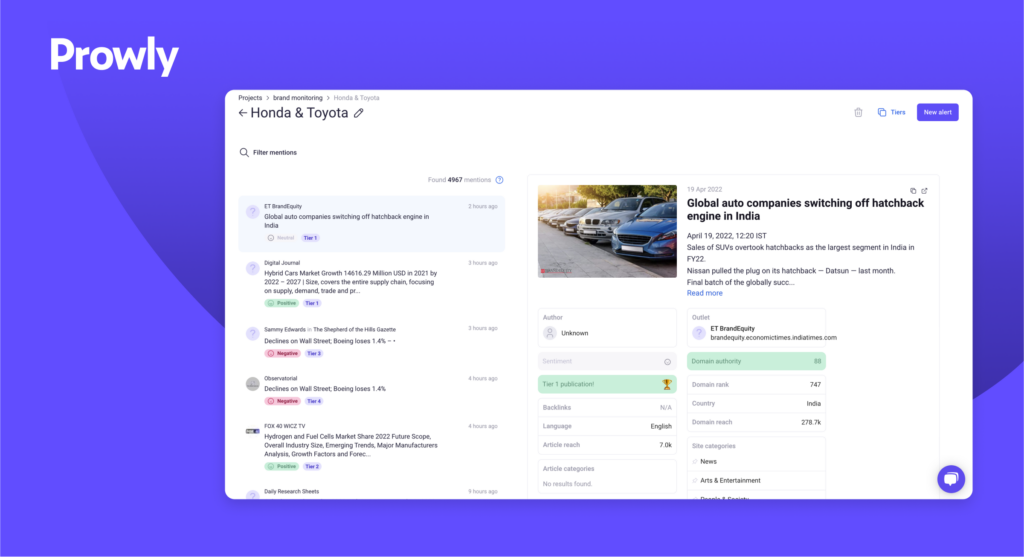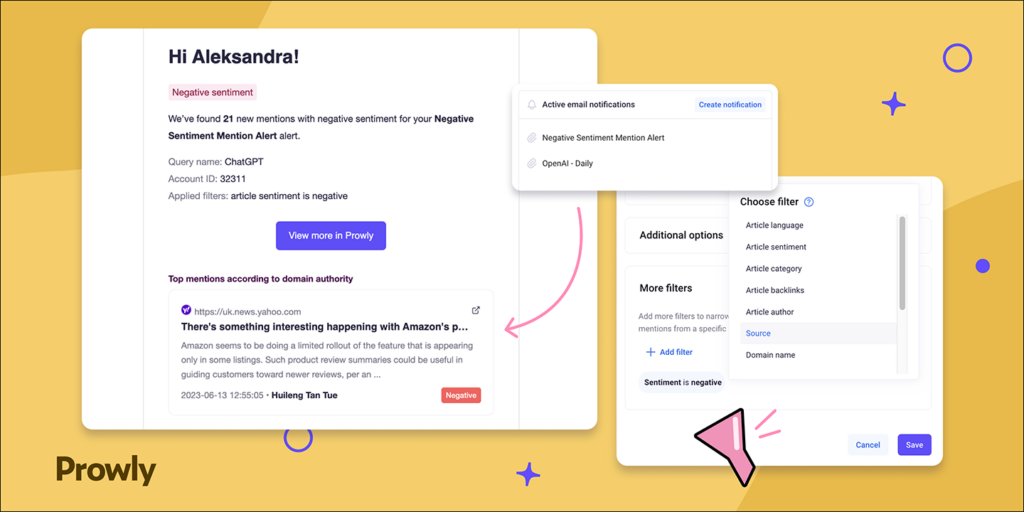What does it mean to manage social media reputation? On paper, it's about answering comments and reacting to UGC, but it includes so much more work in the real world.
Managing your social media reputation is all about keeping an eye on how people see your brand, handling issues with care, and rebuilding trust when it matters most. So what should you do to take care of the social media reputation management aspect of your brand?
This guide will walk you through essential strategies and provide a clear action plan to help you succeed.
💡 Prowly can help you monitor brand mentions across both online and offline media. You can try it for free right away—or read this guide first.
The dynamics of social media reputation management
Everything in the digital world is happening now. And it's changing fast.
A single incident can go viral and damage your brand image significantly. Sometimes, it is a matter of minutes!
So, to cope with this fast-paced world, you need to understand how to monitor and control conversations across social media and precisely when and where you should put valuable insights.
You should put your effort into reputation marketing when it comes to online reputation. You need to build a positive perception of your brand across social media.
This means delivering value but also building a community and interacting with it. Such actions need resources and tools to monitor social media platforms in order to catch and respond to any new mention.
Also, you need to address negative feedback proactively to avoid further damage control.
Try Prowly's media monitoring free for 7 days
Start tracking your brand and keywords for free (no credit card required) in Prowly.
- Comprehensive monitoring: Track the web and social media mentions.
- Transparent pricing: Plans start at $258/month
- All-in-one platform: Get everything you need in one tool for PR, incl. media database, outreach, reporting, and more
Lack of proper brand reputation management - life-based examples
Example #1: Balenciaga
In 2022, Balenciaga faced criticism for an ad campaign featuring children with teddy bears in bondage gear. As it led to accusations of sexualizing children.
📩 Poor Response: Initially, Balenciaga denied responsibility and filed a lawsuit against the production company. Only after intense backlash did they issue apologies and take responsibility.
👉 Outcome: The brand lost followers and saw a decline in sales, highlighting the importance of swift and sincere responses to crises.
Example #2: Lululemon
The clothing brand faced criticism for quality control issues, particularly with its "see-through" yoga pants.
📩 Poor Response: The brand eventually addressed the issue, but the initial response was slow, leading to a temporary stock price drop. The lack of proper reputation management strategies was clear.
👉 Outcome: Customers were able to return these too-revealing pants. And in the end, the company implemented better quality control measures and recovered from the crisis.
Example #3: Uber
Uber has been involved in multiple scandals, including allegations of sexism and unethical practices. Moreover, CEO Travis Kalanick's inappropriate comments have contributed to a negative brand image and poor company perception.
📩 Poor Response: While Uber eventually took steps to address these issues, the initial response was slow, leading to significant brand damage.
👉 Outcome: The company lost users and faced legal challenges, ultimately leading to changes in leadership and policies.
Example #4: United Airlines
In 2017, United Airlines faced a major backlash after a passenger was violently removed from an overbooked flight. The incident was captured on video. And as you may assume, it went viral, sparking widespread outrage and damage to their social media reputation and overall brand image.
📩 Poor Response: Initially, United's CEO defended the flight crew's actions. This exacerbated the situation. There were several follow-up statements and apologies from the airline to attempt to rectify the situation, but the damage had already been done.
👉 Outcome: United lost millions in value shortly after the incident and continues to face challenges in regaining public trust. Once something goes viral on social media, an online reputation may not recover promptly.
The core elements of social media reputation management
There are three pillars of effective reputation management. Each of them plays a crucial role in coping with the brand's online presence, how it is perceived, and how fast it can recover from any negative events.
Part 1: Monitoring
This covers monitoring brand mentions across media outlets, analyzing customer sentiment, and following trends in real time. To gain a positive reputation, first you need to focus on your brand visibility. Once people should know you, they start talking about you.
The basis of your social media presence is, first, a proper content plan, and second, following and responding to brand mentions. This way, you will be able to build community.

But, unfortunately, the world is not always a cute place. Sometimes, you may be forced to react to negative comments.
So, prepare a decent crisis management plan and provide sentiment analysis to keep lock and loaded (this is a second pillar action).
Part 2: Response
As mentioned above, as you start monitoring, you will be able to detect any minor changes in your audience's behavior.
Thanks to sentiment analysis, you can recognize people's attitudes and perceptions of your brand as they shift in real time.

This gives you the time to implement one of your reputation management strategies before eg, a big wave of hateful comments arises. It's better to be safe than sorry, especially when it comes to social media.
Part 3: Recovery
But once a wave hits, you need to start repairing with your online reputation management plan.
You need to start gaining trust again and rebuild severed bonds with your audience. By following your social media and performing sentiment analysis across all platforms, you will be able to track when and if your actions work.
All of the above pillars are doable with reputation management tools. Prowly offers full media monitoring features. Moreover, you can receive a sentiment analysis and react to mentions in real time.
Try Prowly's media monitoring free for 7 days
Start tracking your brand and keywords for free (no credit card required) in Prowly.
- Comprehensive monitoring: Track the web and social media mentions.
- Transparent pricing: Plans start at $258/month
- All-in-one platform: Get everything you need in one tool for PR, incl. media database, outreach, reporting, and more
💡 Tip: If you want to make your PR strategy truly robust, read these articles to learn how to manage your brand reputation and protect its reputation.
Real-time monitoring: keeping a finger on the pulse
All reputation management strategies should include real-time monitoring. It helps detect potential crises or even larger issues early on. Allowing you to address concerns before they escalate.
So what should you do? Start with the right reputation management tools. Or just the perfect fit for you.
Social listening tools give you a peek into brand sentiment.
Brandwatch, Meltwater, or HubSpot all allow you to monitor what is going on across social media. But Prowly also gives you a way to monitor your competitors and keywords related to your brand. You can react promptly and nip the issues in the bud.
P.S. You can read a comparison of sentiment measurement tools and pick the one that's just right from this guide.

Prowly is an all-in-one tool, you can set up alerts for any terms you are interested in as well as negative spikes. So nothing will catch you off guard.
What is more, social media reputation management tools like Prowly support you in analyzing engagement patterns to predict potential crises.
With this in hand, you can make data-driven media reputation management decisions. Moreover, it helps you detect trends and create a social media strategy based on real numbers.
Crisis handling and response strategy
There is no way to really avoid all negative comments or actions towards your brand. Sometimes, it takes just one mediocre, unsatisfied customer experience.
However, a structured response plan is crucial when facing public criticism and misinformation. A brand's reaction can be game-changing when it comes to such situations.
Negative feedback mini guide: how to handle it properly
There are three things you can go to:
1️⃣ Respond to constructive feedback.
And what is important is to react to issues that can be resolved through a public or private conversation. This approach shows engagement and care for customer concerns. As a benefit, it helps to build trust and potentially turn a negative experience into a positive one. So be sure to respond timely, empathetically, and stay solution-oriented.
2️⃣ Ignore comments that are spam, abusive, or unrelated to your brand.
Trolls are gonna be trolls. Engaging with these can escalate minor situations and draw unnecessary attention to negative content. The Barbra Streisand effect at its best. However, it's important to monitor these interactions to ensure they don't become a trend or affect your brand's perception.
3️⃣ Escalate feedback, especially serious complaints, legal issues, or sensitive topics.
These matters should be handled via private channels or involve higher management to be managed appropriately. This ensures that complex issues are addressed thoroughly while minimizing public exposure.
The importance of timely reactions in shaping public perception
When it comes to public perception, timing is everything.
Sometimes it is like a fire – the faster you act, the less damage it does.
For example, if a business addresses a bad review immediately, it can turn an unhappy customer into a loyal fan. On the flip side, waiting too long to react can make things worse. People start to wonder if you’re hiding something or don’t care, which can hurt your reputation long-term. They may think that all this time you've waited, you could have used to create a story to make you look better.
Even in big situations, like emergencies or political events, how quickly leaders share accurate information shapes the public's mood about what’s happening.
It’s all about being proactive. Staying silent or being slow to respond leaves room for rumors and misinformation to spread, while quick, honest communication builds trust and keeps people on your side.
P.S. Here’s an article that might come in handy if you’re looking for a tool to measure the impact of your communication efforts.
Crisis response examples - how to do it
Example #1: Pepsi: The Kendall Jenner ad controversy
In 2017, Pepsi released an ad featuring Kendall Jenner that was criticized for appropriating imagery from social justice movements. The backlash was immediate and widespread.
How did they respond?
The company reacted quickly and pulled the ad. They issued a public apology, acknowledging they had "missed the mark" and expressing regret for any offense caused. This swift action helped minimize long-term damage to the brand's reputation. It was a by-the-book reaction.
🗝️ Key takeaway
A quick and sincere response is a go-to reputation management step. It can mitigate reputational harm.
Example #2: KFC chicken shortage
Supply chain issues left most UK/Ireland restaurants without chicken, risking brand loyalty. In short, Kentucky Fried Chicken offered no chicken.
How did they respond?
KFC ran cheeky ads rearranging their logo to “FCK.” They also created a page tracking chicken availability. There was also a social media reputation involvement. The company engaged transparently on social media.
🗝️ Key takeaway
A sense of humor and transparency aligned with their playful brand reputation and voice. It was proof that you can turn a disaster into a relatable moment that boosts goodwill.
Example #3: CPK’s viral TikTok Mac ’n Cheese fail
A customer’s TikTok video exposing a ridiculous order error (cheese-only mac ’n cheese) by going viral.
How did they respond?
CPK’s CEO, Chef Paul, responded directly on TikTok with a sense of humor. Then gifted the customer free meals for a year.
🗝️ Key takeaway
Meeting criticism on the same platform it originated from kept the conversation fresh and humanized the brand. Staying on the same medium shows that the brand speaks with the customer's voice and helps manage the brand's reputation smoothly.
The role of customer service in reputation management
When it comes to media reputation management and social media strategies related to it, customer interactions are crucial. You can quickly turn your critics into advocates or they may become your biggest enemies.
Public vs. private responses: how to handle these conversations
Okay, let's break down when to talk in a public forum and when to have a private chat. Or when it is better to share a statement via IG stories or other platform.
Talking to everyone publicly
Scenario 1: When things go wrong (big time):
If something major happens, like a legal issue, product error, or a big mistake, it's important to say something publicly. And fast. This helps you control the story and stop rumors from spreading. It should be a quick (but well thought out) and honest announcement.
Scenario 2: Giving out real information:
During emergencies or when things are changing quickly, use social media to give people the facts. This keeps everyone informed and helps build trust.
Scenario 3: Answering common questions:
If a lot of people are asking the same questions or if rumors are going around, answer them publicly. This way, everyone gets the same correct information.
Talking privately
Scenario 1: When things get personal or complicated
With someone's private information, legal details, or a really emotional situation, take the conversation to DMs. Do not bring the spotlight to it.
Scenario 2: When things get heated
If someone is being aggressive or keeps arguing, don't keep it going in public. It would be fuel on the fire. Move the conversation to a private space and try to resolve the issue calmly.
Scenario 3: When you need to get technical
If you are troubleshooting a technical issue, or dealing with operational details, go to DMs. This keeps the public feed clean and allows for a more focused and detailed conversation. Moreover, it will keep your media reputation clean.
Turning complaints into wins: how a good response can shift negative sentiment
Follow the below rules to create answers that will boost your online reputation and help you create a safe space for your customers.
Step 1: Acknowledge and empathize
People like to be seen and heard. Start by validating the customer’s frustration. Phrases like “I can imagine how frustrated you must have been because of this” to show you’re actively listening. De-escalating tension and setting the stage for resolution is a vital step in reputation management.
Step 2: Ask questions to clarify
You need as much information as you can get. So gather details with open-ended questions like “Can you explain what happened?” This ensures you address the root issue and avoid assumptions.
Media reputation management is based on handling the causes and avoiding such actions in the future.
Step 3: Apologize sincerely
Social media reputation management is all about how people feel. So even if the customer is partially at fault, apologize for the inconvenience. It is common knowledge that apologies reduce negative sentiment more effectively than compensation alone.
Step 4: Give a clear solution
Reputation management covers a solution as well. Provide actionable next steps, such as a refund, replacement, or troubleshooting guide. This will help you cover your final media reputation management touch-ups and take care of your brand image.
Step 5: Follow Up
Do a check-in to confirm satisfaction and gather feedback. This reinforces trust and helps improve processes. It can also be a social proof that you can publish across your social media platforms. After gaining permission, of course.
Automation vs. human touch: when to use chatbots and when people need other people
Check what type of situations you can rely on AI and chatbots for and when you should handle situations personally.
📈 Where AI chatbots excel
- Speed and scalability
There is no doubt that AI beats human work when it comes to time. It can generate responses in seconds. Moreover, it is easier to scale these solutions than to hire new staff.
- Personalization at scale
Retailers are using AI to give you personalized shopping experiences, with tailored product advice and tools to recover abandoned carts. In the beauty world, chatbots are adding augmented reality features, like virtual makeup try-ons, making online shopping more interactive and engaging. There is immense opportunity here to really move your brand into direct conversations with your customer base.
- 24/7 availability
AI needs no sleep, so chatbots operate around the clock. They can address basic queries e.g., shipping updates, FAQs instantly and at any time.
📉 Where AI chatbots fail
- Emotions and empathy
Social media reputation management requires emotions and some dose of empathy. AI struggles with these. Microsoft Copilot even became confrontational when users repeated questions, while DPD’s chatbot swore at customers and criticized its own company. For sure, these are not the emotions dissatisfied clients are looking for. These failures highlight AI’s inability to mirror human emotional intelligence.
- Critical errors and bias
AI is trained based on things that have happened before. If new problems occurs or there are critical problems which AI is not trained well for, its mistakes may cost you a lot. Not only in the case of reputation management, but money wise as well.
- Broken escalation protocols
When issues require human intervention, poorly designed handoffs frustrate users. When chatbots loop users with generic replies instead of escalating issues, frustration grows—and screenshots of these interactions can go viral on social media, harming your brand's reputation.
Pro Tip: Create a "Let me connect you with a specialist" answer and allow users to switch to a real person at will. This way your online reputation may avoid potential cracks.
Building a reputation recovery plan
Reputation recovery requires a structured approach to regaining audience trust. A poorly executed apology or damage control effort can make things worse.
When it comes to social media reputation management there is a thin line to tread. You should be careful with every piece of content you publish when crisis arises.
👉 Monitor your brand mentions with social media reputation management tools and think ahead.
👉 Be prepared to publish effective statements and rebuild your online reputation swiftly.
P.S. Check out this guide on social media crisis management to fine-tune your strategy with a few practical tips.
What makes a statement effective vs. corporate jargon (with apology framework)
It is not just about being sorry. It is about being sincerely sorry, with the right timing and proper wording. You should learn how to apologise as one of the last steps of social media reputation management. Below you can find short framework:
Effective Apology Framework
1️⃣ Timeliness
As you know, time is a crucial indicator when it come to online reputation management. Respond swiftly to prevent misinformation and to show urgency. Thanks to sentiment analysis, you can forecast people's moods even days ahead to keep one step further and react as soon as the first hints reach you.
2️⃣ Own your mistakes
Use unequivocal language: “We made a mistake” or “We apologize for…” And avoid conditional phrases like “If you feel offended.” When it comes to media reputation, you apologize to everyone, all of your consumers, not only those who may feel wronged by your actions.
3️⃣ Transparency
Explain the issue clearly and take corrective steps. If you can, support your words with data and explain all the "whys." Samsung halted production of the Galaxy Note 7 and later emphasized quality reforms after damaging incidents, aligning their actions with words.
4️⃣ Empathy and Restitution
Acknowledge harm with phrases like “We understand this caused frustration,” and offer tangible fixes, e.g., refunds, policy changes, etc. You can also think about investing in charity or other CSR events.
Check out which phrases are no-go when it comes to public apologies and which support your media reputation recovery.
Looking for a comprehensive all-in-one PR tool?
Try Prowly completely free for 7 days in a platform with everything you need for PR.
- All-in-one software: Get everything you need in one tool for PR, incl. media database, outreach, reporting, and more
- Transparent pricing: Plans start at $258/month
- Comprehensive monitoring: Track the web and social media mentions.
Media reputation recovery: trusted voices of influencers & community engagement
The core of social media are the influencers. So benefit from their world with social media reputation management. Use reputation management tools to track crucial voices in your niche.
Partner with authentic influencers
Select influencers who align with your brand values and have a history of transparency. Do not search for those who are controversial or only recently improved their social media reputation. Allow them to share unfiltered experiences and do not cross the line with overly promotional content.
Support communities
Create dedicated spaces, like social media groups, broadcast channels, or threads for customers to share feedback and connect. Respond promptly to concerns, be engaged with these spaces and share updates form your brand's life.
Benefit from user-generated content
The perks of using social media reputation management tools can be fully realized in brand mentions. So anytime users post and tag you, you will know. Share these on your social media and show your gratitude. Use it as a social proof that people actually like your brand to boost your social media reputation.
30-Day social media reputation management action plan
One of the best decisions you can make in order to take control of your media reputation is to choose one of the many reputation management tools on offer. Below you can find the structured plan to assess, manage, and improve social media reputation with Prowly.
Week 1: Set up monitoring systems and audit social media reputation
Objective: Establish a system for real-time reputation tracking and identify existing perception gaps.
- Activate social listening features with Prowly to monitor brand sentiment.
- Audit recent brand mentions across platforms to assess current social media reputation.
- Identify key risk areas (customer complaints, misinformation, negative reviews) to create a starting point for your social media reputation management plan.
- Benchmark against competitors to compare perception and engagement trends across various social media platforms.
Week 2: Define response guidelines and train your teams
Objective: Ensure the brand has a clear, structured approach to handling reputation risks.
Social media reputation management needs a response framework for different types of feedback and to various social media.
- Establish escalation procedures for handling serious reputation threats. Once something endangers your social media reputation, you need to know how to react.
- Create response templates to maintain consistency and speed.
- A crucial step in social media reputation management is action. Train customer service and social media teams on best practices.
Week 3: Proactive engagement and trust reinforcement
Objective: Shift from defence to active reputation building.
- Increase community interaction by responding to positive mentions and encouraging UGC. Social media reputation management tools help with that by notifying you anytime someone tags you.
- Launch trust-building campaigns, like behind-the-scenes content. Use social media platforms to show "the inside" of your brand.
- Partner with industry advocates to amplify credibility. This should be the core of social media reputation management.
- Address recurring complaints publicly to show transparency and your commitment to improvement.
Week 4: Measure, adjust, and secure long-term stability
Objective: Check progress, refine strategies, and maintain ongoing social media monitoring.
- Compare sentiment analysis results from W1 to track improvements.
- Refine response strategies based on engagement and feedback data.
- Ensure consistency and implement long-term monitoring KPIs for continued improvement in social media reputation management.
Social media reputation management - key takeaways
Social media reputation management is an ongoing process requiring ongoing monitoring, active responses, and keeping proactive.
Brands that actively manage their social media reputation instead of waiting for crises to emerge maintain stronger, more resilient credibility.
To make sure you take the best care possible of your brand and its social media reputation, choose a tool that will monitor both–online and offline mentions 24/7, and alert you exactly when the crisis just starts to emerge.
Looking for a comprehensive all-in-one PR tool?
Try Prowly completely free for 7 days in a platform with everything you need for PR.
- All-in-one software: Get everything you need in one tool for PR, incl. media database, outreach, reporting, and more
- Transparent pricing: Plans start at $258/month
- Comprehensive monitoring: Track the web and social media mentions.






